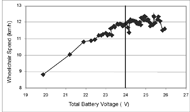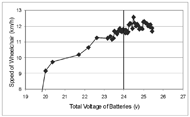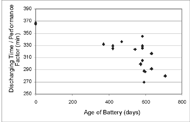Accelerated Testing for Powered Wheelchair Batteries: Preliminary Results of Charging, Discharging and Field-related Data
Seyed Hossein Mohammadian Masooly, PhD Candidate; François Routhier, PEng, PhD;
Centre for Interdisciplinary Research in Rehabilitation and Social Integration (CIRRIS),
Institut de réadaptation en déficience physique de Québec, Québec, Canada.
ABSTRACT
The general goal of this project is to suggest an accelerated testing procedure for powered wheelchair batteries. In this study we focused on charging and discharging behaviour. From the “charging test” we found a linear relationship between battery voltage and LED reading. The “discharging test” revealed a decrease in wheelchair speed when the total battery voltage reached ±24.0V (or ±12.0V for each battery), so we defined the “performance factor” of a single battery as the discharging time from nearly fully charged (±12.7V) until it reached ±12.0V. As the third test, we conducted “performance tests” (from fully charged [±12.7V] to completely discharged [±12.0V], out of wheelchair and for each battery individually), showing the degradation of the performance factor of batteries in long-term use. Accelerated testing can now be performed based on the results obtained from these field tests.
KEYWORDS
Powered wheelchair; accelerated testing; VRLA batteries; charging; discharging; field-related data.
BACKGROUND
Degradation of powered wheelchair batteries over time is one of the most important concerns from the viewpoint of user satisfaction and economic issues of replacement. The energy storage system is one of the greatest limiting factors on the performance of powered wheelchairs [1, 2]. Many studies have been conducted by researchers and manufacturers on the life of lead acid batteries regardless of their real applications, but not necessarily on the performance they can provide for an application such as powered wheeled mobility. Regarding the long consumption time to degrade valve regulated lead acid (VRLA) batteries, which is one of the main battery types used for powered wheeled mobility, and the wide range of wheelchair user behaviours, as noted in the study by Routhier et al. [3], the general goal of this project is to suggest an accelerated automated battery test procedure [4] and to express the performance of powered wheelchair batteries using mathematical formulas [5]. Accelerated testing seeks to compress long service exposures into a shorter laboratory test by increasing the amplitude and/or frequency of the applied inputs during the laboratory test relative to the amplitude and/or frequency experienced during service [6]. Prior to completing accelerated testing, some data from field-testing could be collected.
OBJECTIVES
Regarding the need for field-related data for accelerated testing, including charging and discharging behaviours of VRLA batteries, the objectives of this paper are to: 1) determine the relationship between the LED reading on powered wheelchairs and battery voltage during charging, 2) determine the state-of-charge of batteries when wheelchair speed decreases and consequently define a performance factor to explain the quality of batteries, and 3) obtain this performance factor for used and new batteries to obtain their degradation rate in terms of discharging time.
METHOD
Three different types of test were done on VRLA-powered wheelchair batteries to achieve our objectives. The batteries tested were AGM/Gel batteries manufactured by Power Batteries (model WCG-24, 12.0 Volts, capacity at C/100: 76 A-hr). Each new battery used for the tests had already gone through 10-15 charging/discharging cycles according to the manufacturer’s instructions to acquire the highest level of capacity. For objectives 1 and 2, we focused on the charging characteristics of a pair of batteries (installed on wheelchair) instead of charging each battery individually, because it represents the reality of wheelchair use. All tests were done in a similar temperature condition of 25±2°C. A typical powered wheelchair (manufactured by Orthofab, Oasis 2 model, 300W motor with maximum speed of 12km/h) was used for objectives 1 and 2.
Objective 1
The first test, called “charging test”, focused on obtaining a relationship between LED readings on powered wheelchairs, which enables wheelchair users to recognize the state-of-charge of their batteries during use, and battery voltage. A 24.0V wheelchair battery charger (Lester, dual mode automatic battery charger, 24.0V, 8.0A), one pair of new and one pair of used AGM/Gel batteries, a chronometer and a voltmeter were used. Voltage and LED reading were recorded every 30 minutes. Each pair of fully-charged batteries was then discharged by a “discharging test” (see below).
Objective 2
For the second test, called “discharging test”, we used the same equipment as for the charging test. The discharging test was done in an indoor parking lot located in a rehabilitation centre building in Quebec City (Institut de réadaptation en déficience physique de Québec). Each circuit (turn) measured 250m. During driving and for each 5 circuits, we obtained the approximate wheelchair speed by measuring the time taken to travel 40m. Also, after each 5 circuits, the wheelchair driver stopped and the wheelchair controller was turned off to measure the battery voltage. This test was done for a pair of new batteries, at high (approximately 12 km/h) and low (approximately 3 km/h) speeds, and for a pair of used batteries only at high speed. Thus 3 experimental conditions were tested.
Objective 3
The third test, called “performance test”, was done to measure the “performance factor” of new and used batteries in controlled conditions. We collected 17 used batteries returned by wheelchair users because they claimed they did not have enough power to run the wheelchairs like before. Their ages (working days) were recorded. Two new batteries (age=0 day) were also tested, for a total of 19 batteries. To speed up the test, we used 2 commercial 12.0V chargers and 2 homemade 6.0-6.5A electrical resistances as constant dischargers, a chronometer and a voltmeter. We charged each battery fully, then discharged it individually. During discharging, we stopped discharging and measured the voltage at different intervals. The performance factor was obtained by measuring the time taken (in minutes) to discharge it from 12.7V to 12.0V.
RESULTS
From the charging test, we obtained the relationship between voltage and LED reading while charging a pair of batteries (Figure 1). The voltage increases at an almost constant rate as does the LED reading.
The results of the discharging test are shown in Figures 2 and 3. By simply observing these diagrams, we can conclude that wheelchair speed begins to decrease when the total battery voltage drops below 24.0V for both new and used batteries.
For the performance test we charged each battery individually, then discharged it at a rate of 6.0 to 6.5A. Figure 4 shows the time taken to discharge (performance factor) the 19 batteries tested from ±12.7V to ±12.0V in relation to their full working days. Clearly, we can observe a general degradation in the performance factor and scatter data due to different customer use profiles
DISCUSSION
The charging test revealed a close relationship between battery voltage and LED reading. Therefore, henceforth, instead of referring to LED, which is a reading observed by wheelchair users to recognize state-of-charge, we propose to consider only battery voltage in our future accelerated tests. From the discharging test, we concluded that a reduction in wheelchair speed (for both new and used batteries) relates to battery voltage. At about 24.0V, wheelchair speed tends to decrease, which induces wheelchair users to charge them again. In long-term use, the decrease in speed over time could be perceived by wheelchair users as degradation (loss of performance) of their batteries and the need to change them. Accordingly, we defined the performance factor of batteries as the time taken to discharge a battery from ±12.7V (almost fully charged) to ±12.0V. Performance testing on new and used batteries demonstrated that the degradation of batteries strongly depends on their age. The results shown in Figure 4 could be compared to future accelerated testing results in order to obtain a correlation between accelerated testing time and battery ages in which both result in the same degradation effect. From the results obtained from these tests, we can claim that we have accomplished the preliminary stage of our objectives. An accelerated testing procedure can now be developed and carried out.
REFERENCES
- Cooper, RA. (1995). Wheelchair safety, standards and testing. In: Rehabilitation engineering applied to mobility and manipulation. Medical Science Series. Institute of Physics Publishing, Bristol and Philadelphia, pp. 219-254.
- Kauzlarich, JJ, Ulrich, V, Bresler, M, & Bruning, T. (1983). Wheelchair batteries: driving cycles and testing. Journal of Rehabilitation Research and Development, 20(1), 31-43.
- Routhier, F, Fortin, B, & Guérette, C. (2004). Autonomy of gel cell and wet cell lead acid batteries for motorized wheelchairs: Preliminary results. RESNA 2004 - 28th International Conference on Technology & Disability: Research, Design and Practice. Orlando, FL, USA. June 18-22.
- Pasco, PE, & Anbuky, AH. (2003). Automated battery test system. Measurement, 34, 325-345.
- Anbuky, AH, & Pascoe, PE. (2000). VRLA battery state-of-charge estimation in telecommunication power systems. IEEE Transactions on Industrial Electronics, 47(3), 565-573.
- Farrar, CR, Duffey, TA, Cornwell, PJ, & Bement, MT. (1999). A review of methods for developing accelerated testing criteria. Proceedings of the 17th International Modal Analysis Conference, Kissimmee, FL, USA, pp. 608-614.
ACKNOWLEDGEMENTS
This project is supported by the Quebec Health Insurance Board. François Routhier holds a postdoctoral fellowship from the Institute of Aging of the Canadian Institutes of Health Research (CIHR) (2005-2007) and from the FRSQ (2004 and 2008).
Contact Information:
Seyed Hossein Mohammadian Masooly, Département de génie mécanique, Université Laval, Pavillon Pouliot, Québec, Canada, G1K 7P4. Phone: 418-656-2131 ext. 12244. Email: seyed-h.mohammadian.1@ulaval.ca.



